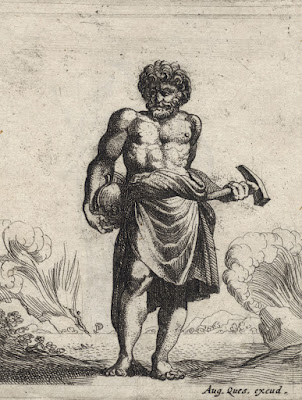Unidentified artist
Augustin
Quesnel (1595–1661) (publisher)
“Vulcanus” (aka “Vulcan" or “Hephaistos”), c1620, after
Plidoro da Caravaggio (c1500–1536/7?) perhaps also after Raffaello Guidi (fl1585-1615)
and Hendrik Goltzius (1558–1617) who both made interpretative prints after Polidoro
da Caragaggio’s design.
Etching on laid paper trimmed along/near the platemark and
re-margined on a support sheet.
Size: (support-sheet) 26.5 x 22 cm; (sheet) 9.9 x 7.8 cm
Inscribed on plate at lower right: “Aug. Ques. excud.”
Condition: a crisp, richly inked and excellent impression in near
perfect condition (i.e. there are no tears, holes, folds, stains, foxing or
significant signs of use) trimmed along the platemark laid upon an archival
support sheet.
I am selling this little gem from the Renaissance era showcasing
the interest in Roman gods for AU$189 (currently US$147.23/EUR120.30/GBP106.51
at the time of posting this listing). Postage for this print is extra and will
be the actual/true cost.
If you are interested in purchasing this print of Vulcan showing
not only his attributes (the blacksmith’s hammer and casque) but also a
landscape featuring a figure attending to, or collecting, Vulcan’s fire, please
contact me (oz_jim@printsandprinciples.com) and I will send you a PayPal
invoice to make the payment easy.
This print has been sold
Sadly, I have been unable to establish the name of the etcher who
made this small, but graphically strong, image of Vulcan, nevertheless, I have no
problem attributing the original design to Polidoro da Caravaggio as there are
two very famous prints after his design interpreted by Raffaello Guidi and Hendrik
Goltzius. Despite the clear similarities in the way that Vulcan is portrayed in
these prints, there is a significant difference in the contextual setting for the god
that makes this composition unique: a landscape (or is it a seascape?) setting
for Vulcan rather than the niche setting of Guidi and Goltzius.
What makes the
landscape setting very interesting for me is that it celebrates
Polidoro’s fascination with chiaroscuro (i.e. theatrical side lighting) and
contre-jour effects (i.e.back lighting) the latter of which
is not evident in the versions by Guidi and Goltzius. For those unfamiliar with
Polidoro’s artwork, he is best known for his black and white frescoes. What has
made Polidoro’s name most memorable is not what should make an artist famous:
he was murdered by his studio assistant.








No comments:
Post a Comment
Please let me know your thoughts, advice about inaccuracies (including typos) and additional information that you would like to add to any post.